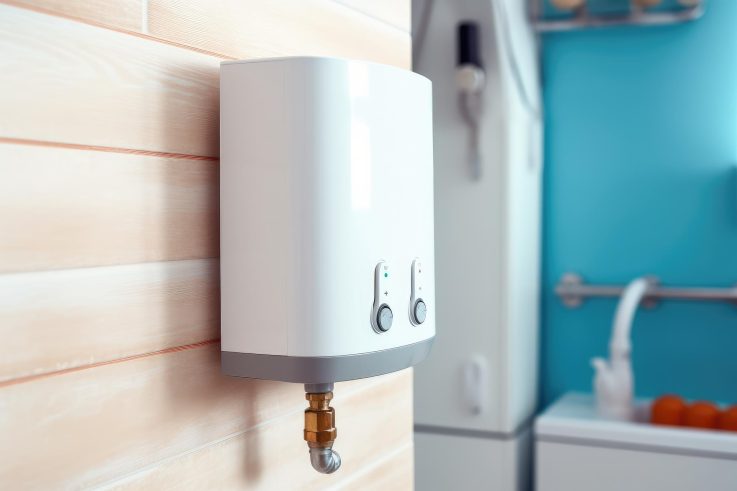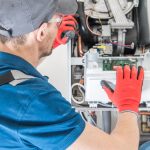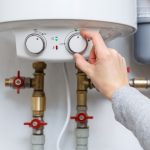
On-Demand Hot Water: A Homeowner’s Guide to Tankless Water Heaters
If you’ve ever waited—and waited—for your shower to warm up, you already understand the appeal of instant hot water. Modern tankless systems deliver heated water on demand, which means you aren’t paying to keep 40–75 gallons hot all day. In this comprehensive guide from Super Green HVAC, you’ll learn how tankless technology works, when it’s the right fit, what it costs, and how to design a system that actually delivers instant hot water at every tap you care about.
Along the way, we’ll translate jargon, compare fuel types, and show you simple strategies that turn “spec-sheet efficiency” into lower bills and better comfort. Most importantly, we’ll help you set realistic expectations about instant hot water so your project performs on day one—and for years to come.
What “Instant Hot Water” Actually Means
“Instant” is about availability on demand, not magic. With tankless equipment, burners or heating elements ramp up only when a tap opens. Heat is transferred to incoming cold water as it flows through a compact heat exchanger. The result is effectively endless instant hot water—limited by the unit’s capacity and your home’s flow rate.
The key idea: no standby tank
Traditional tanks keep a large volume hot 24/7, which wastes energy through standby losses. Tankless avoids most of that, which is one reason homeowners see meaningful savings while enjoying instant hot water.
Reality check on “instant”
You still need to move cooled water out of the pipes. That’s why some homes add a recirculation strategy—more on that below—to make instant hot water feel truly immediate at distant fixtures.
How Tankless Heaters Work (Without the Hype)
Tankless systems sense flow, ignite, and modulate heat output to match demand. Because they ramp continuously, they maintain outlet temperature more consistently than many storage tanks, especially during long showers where instant hot water matters most.
Gas vs. electric
- Gas (natural gas/propane): High output and excellent modulation; most common for whole-home systems.
- Electric: Simpler installs in some spaces and useful for point-of-use; may require panel upgrades for whole-home loads.
Condensing vs. non-condensing (gas)
- Condensing units reclaim more heat from exhaust and can vent with PVC, improving efficiency and installation flexibility.
- Non-condensing units cost less up front but use pricier venting and typically deliver lower efficiency.
Either way, the core promise stands: on-demand heating for instant hot water, tailored to the flow you’re actually using.
Sizing: The Secret to Getting Instant Hot Water Everywhere You Need It
Right-sizing is the difference between delight and disappointment. Undersize the unit and two showers plus a dishwasher will outrun capacity; oversize it and you’ll pay more than you need to.
Think in flow rate and temperature rise
- Flow rate (L/min or GPM): Add up simultaneous uses—e.g., shower + sink + laundry.
- Temperature rise: Inlet temperature in Canadian winters can be very cold; raising that to 49–60°C requires serious output for true instant hot water.
Practical example
Two modern showers at ~9–11 L/min combined plus a kitchen sink at ~6–8 L/min can require ~15–19 L/min at a 40–50°C rise. That points to a higher-capacity gas unit or a staged approach (e.g., main unit plus a point-of-use heater) to maintain instant hot water during peak times.
Advantages Beyond Efficiency
Tankless systems are popular for a lot more than smaller utility bills.
Space savings and flexibility
A wall-hung unit frees floor space for storage or laundry. Smaller homes and condos benefit, and retrofits become easier while still delivering instant hot water.
Longer service life
With good water quality and maintenance, many tankless systems last longer than standard tanks, keeping the “on demand” promise of instant hot water reliable for the long haul.
Better for busy households
Whether it’s morning rush showers or back-to-back baths, the “endless” aspect of instant hot water eliminates family scheduling conflicts.
Common Myths About Instant Hot Water—Answered
“Tankless means zero wait time at the tap.”
The unit heats instantly, but water in the pipes still has to be purged. A recirculation strategy brings instant hot water to the fixture faster—details below.
“Electric is always cheaper to run.”
Operating cost depends on local rates and climate. Electric can be great for point-of-use, while gas often wins for whole-home tankless hot water in colder regions.
“Any installer can set one up.”
Tankless rewards craftsmanship. Proper gas sizing, venting, condensate management, and commissioning are mandatory if you want dependable instant hot water.
Installation & Retrofit Considerations
A tidy install is more than hookups—it’s design. Super Green HVAC evaluates your home’s plumbing, gas or electrical capacity, and venting pathways to lock in performance.
Gas supply and venting
Higher-capacity gas units often need larger gas lines and verified meter capacity. Vent runs must meet manufacturer specs—critical for safe, efficient instant hot water.
Electrical requirements
Electric whole-home units may require panel upgrades and multiple dedicated circuits; point-of-use models are lighter lift. Either way, correct wiring ensures stable tankless hot water under load.
Water quality matters
Hard water scales heat exchangers, reducing output and chipping away at instant hot water performance. A scale filter or softener can be a small add-on with big long-term benefits.
10 Little Tweaks That Make Instant Hot Water Feel Instant
- Insulate hot-water lines to reduce heat loss.
- Add a demand-controlled recirculation pump to big homes.
- Place point-of-use heaters at far-flung baths or kitchens.
- Choose low-flow, high-comfort shower heads to stretch capacity.
- Purge nearby tap briefly before jumping in the shower.
- Keep the tankless unit accessible for easy maintenance.
- Use thermostatic mixing valves for stable temperatures.
- Program smart controls for predictable routines.
- Balance fixtures—stagger dishwasher runs during shower hour.
- Schedule annual service to preserve that crisp instant hot water delivery.
Recirculation 101: Making “Instant” Truly Instant at Distant Fixtures
Even with a perfectly sized unit, distant taps can feel slow because pipes act like a small, cooling tank.
Options to consider
- Dedicated return line: Best performance; sends cooled water back to the heater for reheating.
- Crossover valves: Use the cold line as a return path; easy retrofit that speeds tankless hot water without opening walls.
- On-demand buttons or motion sensors: Run the pump only when needed to save energy.
Comfort without waste
Modern, well-controlled recirculation preserves tankless hot water feel while minimizing energy use. Timers, aquastats, and smart controls keep runtime efficient.
Operating Costs, Rebates, and Canadian Resources
Tankless efficiency comes from eliminating standby loss and modulating output precisely. Actual savings depend on usage, fuels, and climate.
For neutral, up-to-date information on energy efficiency and home upgrades, review:
- Natural Resources Canada – Energy Efficiency for Homes
- Government of Canada – Water conservation overview
These resources help you plan upgrades that pair comfort with instant hot water while keeping operating costs in check.
Maintenance: The One Habit That Protects Performance
Annual or bi-annual service keeps your system reliable.
What we do
- Descale the heat exchanger (as needed)
- Clean inlet screens and inspect valves
- Verify combustion, venting, and controls
- Confirm temperature stability at realistic flows
This routine preserves flow and heat transfer, keeping instant hot water snappy at every tap.
Homeowner quick wins
- Clean faucet aerators and shower heads
- Check for slow-closing or sticky mixing valves
- Keep areas around the unit dust-free for better cooling
Point-of-Use vs. Whole-Home: Picking the Right Strategy
Point-of-use wins
- Remote powder room or garage sink
- Studio or accessory suite
- Quick retrofit to guarantee tankless hot water where you notice delays most
Whole-home wins
- Multiple showers and a soaking tub
- Family schedules stack in the morning
- Desire for consistent instant hot water at every fixture
Hybrid approaches
A central tankless plus one or two point-of-use units near distant fixtures can guarantee instant hot water everywhere without oversizing the main unit.
Cost & ROI: Seeing the Whole Picture
Day-one vs. lifetime
Tankless equipment and installation can cost more than a basic tank, but the equation often flips over 10–15 years thanks to lower standby losses and fewer “out of hot water” moments. Add the value of floor space, longer life, and reliable instant hot water, and the long-term case strengthens.
Project scope that matters
- Gas line or panel upgrades
- Venting path and materials
- Water treatment for scale control
- Recirculation hardware and controls
Right-sizing scope keeps budgets realistic while delivering the instant hot water experience you expect.
Smart Controls and Safety
Controls that help
- App-enabled pumps for on-demand recirculation
- Leak detection shut-offs near the unit
- Temperature lockouts to protect kids and guests
Setpoints and mixing
Set domestic hot-water temperature appropriately and use a mixing valve to stabilize output. That combination safeguards comfort and ensures repeatable tankless hot water.
Why Choose Super Green HVAC
Tankless isn’t just another appliance swap—it’s a small engineering project. Super Green HVAC designs and installs systems that make instant hot water feel effortless and energy-smart.
What sets us apart
- Load-first design: We calculate real flows and temperature rise before recommending a model.
- Flawless commissioning: We verify combustion, confirm temperature under real-world flows, and document the results.
- Water-quality strategy: We specify filtration or softening that protects your investment and preserves instant hot water.
- Recirculation expertise: From dedicated returns to smart crossover solutions, we tailor “instant” to your floor plan.
- Respect for your home: Clean work areas, thoughtful routing, and thorough walk-throughs—every time.
When you want instant hot water without surprises, you want a team that treats details like the main event.
Putting It All Together
Tankless technology shines when it’s sized carefully, installed correctly, and supported with simple maintenance. Done right, you’ll enjoy lower standby losses, steady temperatures, and the everyday luxury of instant hot water that keeps up with your routine.
Ready to make cold-start showers a thing of the past? Book a design visit with Super Green HVAC. We’ll evaluate your fixtures, flows, and floor plan, then build a crystal-clear plan to bring reliable instant hot water to the taps that matter most.
Frequently Asked Questions (FAQs)
1) Will a tankless heater give truly instant hot water at every tap?
The heater produces instant hot water the moment flow is detected, but you still need to clear cooled water in the pipes. A recirculation setup or point-of-use unit makes instant hot water feel immediate at distant fixtures.
2) Is gas or electric better for instant hot water?
For whole-home tankless hot water, gas models typically offer higher output and better modulation. Electric can be ideal for point-of-use or smaller homes, but panel capacity must support the load.
3) How do I size a system for instant hot water during busy mornings?
Add simultaneous flow rates and consider winter temperature rise. Super Green HVAC sizes equipment so your peak routine still feels like instant hot water—without wasteful oversizing.
4) Will hard water reduce instant hot water performance over time?
Yes. Scale lowers heat-exchange efficiency. A scale filter or softener protects capacity so instant hot water remains consistent year after year.
5) Can I keep my old tank as backup for instant hot water?
Some homeowners keep a small storage tank or use recirculation with a tankless system. We’ll outline pros and cons so your instant hot water solution matches budget and space.
6) What maintenance keeps instant hot water reliable?
Annual descaling (as needed), screen cleaning, and control checks preserve output. These steps ensure instant hot water stays stable under real-world flows.
7) How much can I save by switching while getting instant hot water?
Savings vary by fuel costs, usage, and climate. Eliminating standby losses and modulating output often lowers bills while delivering the comfort of instant hot water. We’ll estimate savings based on your home’s data.
Want a one-page planning checklist that covers sizing, water quality, and recirculation options for guaranteed instant hot water? Ask us—we’ll send a printable version to keep by your project folder.


